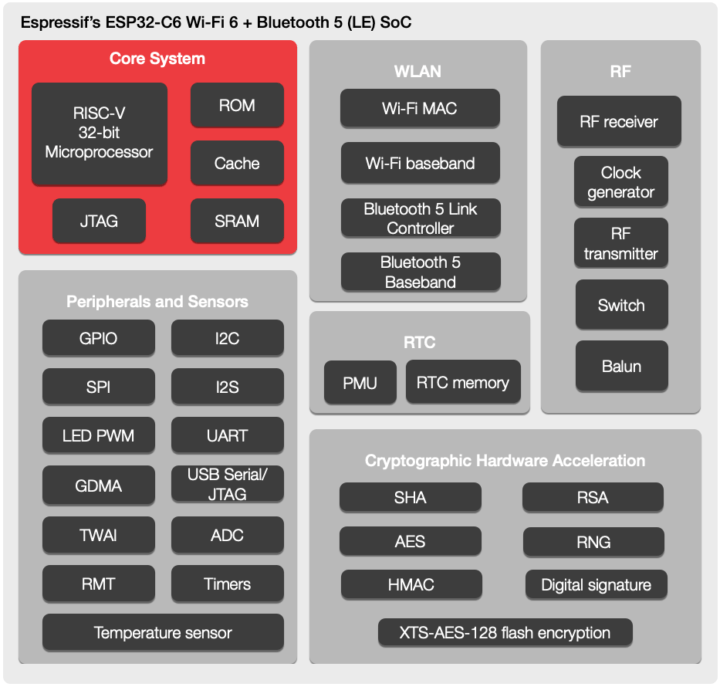Espressif Systems introduced their first RISC-V wireless SoC last year with ESP32-C3 single-core 32-bit RISC-V SoC offering both 2.4GHz WiFi 4 and Bluetooth 5.0 LE connectivity, and while the company sent some engineering samples of ESP32-C3 boards months ago, general availability of ESP32-C3-DevKitM-1 and modules is expected shortly.
But the company did not stop here, and just announced their second RISC-V processor with ESP32-C6 single-core 32-bit RISC-V processor clocked at up to 160 MHz with both 2.4 GHz WiFi 6 (802.11ax) and Bluetooth 5 LE connectivity.
ESP32-C6 preliminary specifications:
- CPU, Memory, and Storage
- 32-bit RISC-V single-core processor up to 160 MHz
- 384 KB ROM
- 400 KB SRAM (16 KB for cache)
- 8 KB SRAM in RTC
- SPI, Dual SPI, Quad SPI, and QPI interfaces for external flash and/or PSRAM
- WiFi
- 2.4 GHz 802.11ax Wi-Fi 6 with 20 MHz bandwidth, support for station interface
- 2.4 GHz 802.11b/g/n WiFI 4 with 20/40MHz bandwidth, 1T1R mode with data rate up to 150 Mbps; Station mode, SoftAP mode, Station + SoftAP
- Bluetooth 5 (LE) radio with support for long-range operation through advertisement extension and coded PHY, and 2 Mbps high throughput
- Peripherals
- 22x programmable GPIOs
- 2x 12-bit SAR ADCs, up to 6 channels
- 3x SPI, 2x UART, 1x I2C
- 1x I2S
- Remote control peripheral, with 2 transmit channels and 2 receive channels
- 1x temperature sensor
- LED PWM controller, up to 6 channels
- Full-speed USB Serial/JTAG controller
- General DMA controller, with 3 transmit channels and 3 receive channels
the Station channel - 1x TWAI controller compatible with ISO 11898-1
- Power Management – Power Management Unit with five power modes
- Security – Secure boot, flash encryption, 4096-bit OTP, up to 1792 bits for users, AES-128/256 (FIPS PUB 197), Permission Control, SHA Accelerator (FIPS PUB 180-4), RSA Accelerator, Random Number Generator (RNG), HMAC, digital signature
Espressif explains ESP32-C6 is basically the same as ESP32-C3 except for the WIFi 6 radio. It also appears that ESP32-C6 does not support optional embedded flash anymore, as the “embedded flash” block has been removed from the block diagram.
WiFi 6 is normally associated with support for dual-band WiFi (2.4 GHz and 5 GHz) like WiFi 5, as well as faster throughput, but the 802.11.ax radio in ESP32-C6 processor is optimized for IoT use cases and only works in the 2.4 GHz frequency band. That means the radio leverages other new 802.11ax features such as the OFDMA (Orthogonal Frequency Division Multiple Access) mechanism for both uplink and downlink communications and MU-MIMO capability for downlink, both of which enable higher efficiency and lower latency. Power consumption can further be lowered with Target Wake Time (TWT) which allows the clients to sleep for extended periods of time and run longer on batteries.
Just like other ESP32 chips, ESP32-C6 will be supported by the ESP-IDF framework, and the company will also make ESP-Hosted and ESP-AT firmware available for customers wanting to control the new processor from an external host.
We still do not know when the new WiFi 6 processor will become available, and Espressif just tells people to contact the customer support team in the press release.

Jean-Luc started CNX Software in 2010 as a part-time endeavor, before quitting his job as a software engineering manager, and starting to write daily news, and reviews full time later in 2011.
Support CNX Software! Donate via cryptocurrencies, become a Patron on Patreon, or purchase goods on Amazon or Aliexpress





